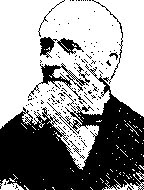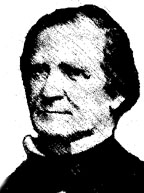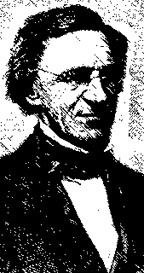|
-- the Relationship between Auburn and the Prison© CHANGES IN THE COMMUNITY
The breaking out of the war of rebellion in 1861 gave an impulse to business of all kinds unparalleled in the previous history of Auburn. Little of the new business was related to the prison in any way. Manufacturing interests centered on the D. M. Osborne & Co. Works, established in 1858, later became the International Harvester Co., the largest manufacturer of grain harvesting machinery in the world, and the E. D. Clapp Enterprises, established in 1864, manufacturers of wagons and wagon parts, and the Auburn Manufacturing Company, establish in 1867, the largest manufacturer of agricultural hand implements in the country at that time. Other smaller enterprises enhanced the industrial reputation of the city. Many of the great men of American agricultural history lived and worked in Auburn at that time.
CHANGES IN THE PRISON By the year 1867 the prison was more of a tradition than a community enterprise. The influence of the reformatory philosophy initiated at Elmira Reformatory in 1876 gradually effected the operation of Auburn Prison. Reformers in the community were appalled by reports of harsh treatment of prisoners working under the contract labor system and the emphasis upon revenue rather than reformation. They protested against the frantic efforts of officials to make the prison pay for itself. To keep the system operating, prison officials were forced to ease up a bit. They began by allowing the silent system to be discontinued in the industrial shops. Foremen were then better able to communicate with workers and thus increased production efforts. Silence was maintained elsewhere but ended entirely in 1910. By the year 1868 the Auburn System had lost some of its glamour as the final solution to the problem of prison administration but, since reformers could not come up with a better system or plan of operation, prisoners continued to be used on contract work. In 1879 there were few idle convicts of the 1,146 men confined at Auburn. Eight hundred seventy-six were on contract at an average daily rate of $.46/man. Two hundred thirty-one other men were employed on state work. Only 31 were unemployed and 22 were either sick or infirm. There were nine convict labor shops at Auburn producing hames, shoes, tools, machines, wooden furniture, barrels, sashes and blinds. The contracts for these items were gradually phased out and by 1890 the contract system was eventually discontinued. The Auburn System was credited with at least four results: it devised a system of prison discipline known worldwide as the Auburn (or silent or congregate) system:
The various features of the Auburn System reflected to a considerable degree the needs, fears, and attitudes prevailing in New York at the time of its adoption; as conditions changed in later years a number of modifications were made, thus providing an interesting record of interaction between a given mode of institutional operation and the environment in which it was developed. INFLUENCE Private sector involvement in prison manufacturing enterprise ended entirely when labor unions gained strength and support in the legislature. The emergence of labor unions in the community developed in the late 1800s. Coupled with administrative abuses of the contract system and the change in public opinion which decreed that contract labor was neither rehabilitating the prisoner nor aiding in his reform, all combined to kill the contract system. This opposition to prison industries had one unfortunate result: enforced idleness among the ever increasing prison population. Of all the serious problems in prison management one of the most persistent is the day-to-day idleness of large numbers of prisoners. Legislators were determined to alleviate this problem at Auburn. THE In 1890 contract labor was replaced by the state use system at Auburn to eliminate idleness among inmates and to turn their labor into productive activities to reduce state expenses. Under the state use system, which is still in use at Auburn Prison, prisoners made goods that could be sold only to other state agencies or departments or used in-house. Convicts were employed so far as possible in the manufacture of articles necessary for their own consumption. Items produced included woolen clothes for prisoners' uniforms, brooms for use in state and school property, steel beds for all types of state institutions, garbage cans, shoes, sheets and pillow cases, wooden furniture, woven baskets, and blankets. Better known are the auto license plates produced in the auto license plate shops since 1920. Inmates receive a compensation for their labors in proportion to their skills. Today compensation varies from a basic wage earned by all inmates who participate in the work program to a higher pay for specialized skills and amount of products completed according to schedule. IMPACT OF The rigidness of the Auburn System then began to break down. The institution now entered the reformatory era which emphasized education and religion provided on a mass treatment basis. There had been few educational opportunities in the early prison. Reading and writing were taught at the Weekly Sunday School by students and professors of the Auburn Theological Seminary who volunteered their services. Their only textbook was the Bible. Convicts were taught how to read and write in order that they might be able to continue to read the Bible and thus earn their own salvation.
The chaplain was practically the only staff member who was a teacher in the era (1825-1845) when prisoners were rarely taught the 3R's. No formal classroom instruction was held. The first legislation governing education was passed in 1847 directing the employment of two part-time teachers who were to be under the direction of the chaplain. They were to teach English in the evenings to inmates who, in the opinion of the warden and chaplain, were able to profit from it. The teachers attempted to give such instruction on the galleries at night after the men had worked a 10-hour day. With the inmate behind a heavy latticed door and the teacher parked on the gallery outside with his book and a flickering lantern in his hand, a situation hardly conducive to learning. This condition continued unchanged for years. PUNISHMENTS A law against punishment by whipping was passed in 1847. The shower bath treatment was used as a substitute for whipping from 1842 to 1859. Whipping, however, was still used sporadically under the guise of self defense. The shower bath, substituted for whipping, was an Auburn original. Usually the prisoner was stripped naked, securely fastened hands and feet with a wooden hopper around his neck to prevent him from moving his head and to hold water up to his chin or even higher. He was seated under a wooden barrel four feet high which held between 30 and 40 gallons of fluid. The discharge nozzle on the bottom of the barrel controlled the flow of water. On the second of December, 1858, a black convict in the penitentiary at Auburn by the name of Samuel More died following punishment by the shower bath treatment. More had put up quite a fight in an attempt to avoid being punished. Four or five barrels of extremely cold water were used in the space of one half hour. When he was released he fell upon the floor, was removed to his cell, and expired in five minutes. The shower bath practice was then discontinued at Auburn but continued at Sing Sing Prison into the 1860s. The paddle and the stocks were used in both prisons until 1882. |





